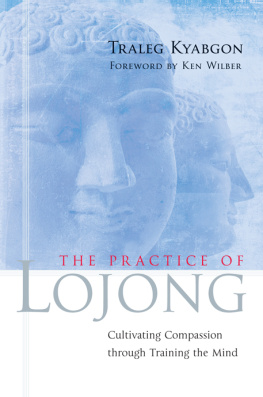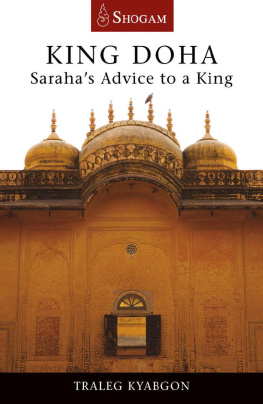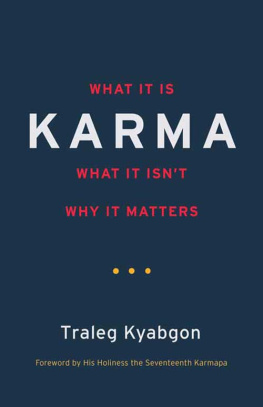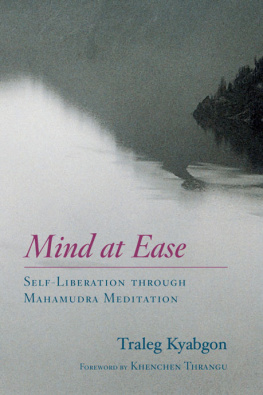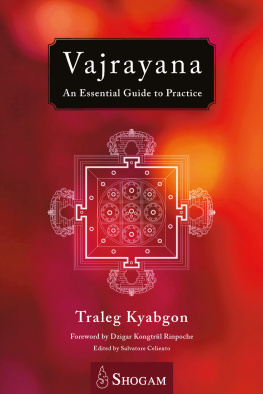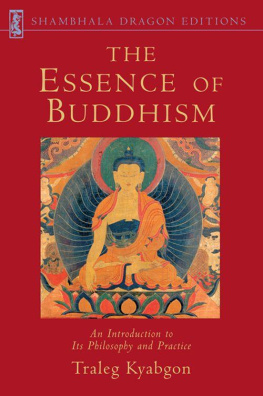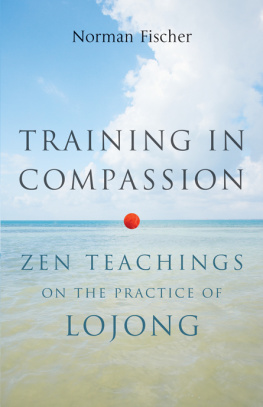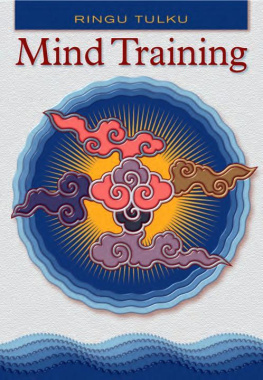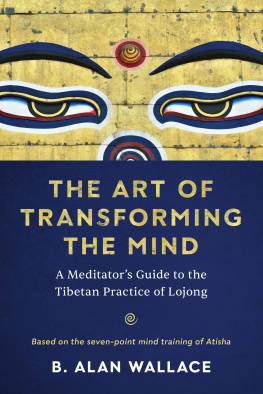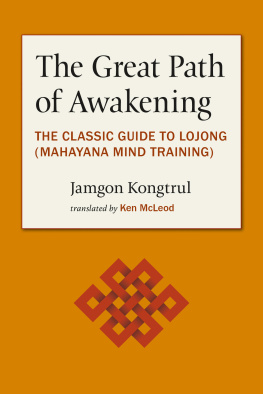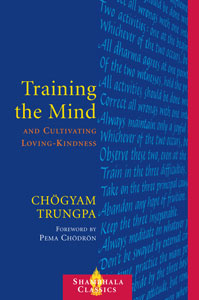These profound Mahayana trainings, practiced for centuries in Tibet, are presented with clarity, compassionate directness, and penetrating insight. This volume should be cherished as the companion of all who seek true meaning in life.
Tulku Thondup, author of Peace Death, Joyful Rebirth
Traleg Kyabgon draws from a wealth of traditional Buddhist sources and brings them into the context of contemporary life and thought. The wisdom of these teachings is equally relevant for all cultures, ancient and modern.
B. Alan Wallace, author of Buddhism with an Attitude
ABOUT THE BOOK
For many centuries Indian and Tibetan Buddhists have employed this collection of pithy, penetrating Dharma slogans to develop compassion, equanimity, lovingkindness, and joy for others. Known as the lojongor mind-trainingteachings, these slogans have been the subject of deep study, contemplation, and commentary by many great masters.
In this volume, Traleg Kyabgon offers a fresh translation of the slogans as well as in-depth new commentary of each. After living among and teaching Westerners for over twenty years, his approach is uniquely insightful into the ways that the slogans could be misunderstood or misinterpreted within our culture. Here, he presents a refreshing and clarifying view, which seeks to correct points of confusion.
TRALEG KYABGON (19552012) was born in Eastern Tibet and educated by many great masters of all four major lineages of Tibetan Buddhism. He is the founder of the Kagyu E-Vam Buddhist Institute, which is headquartered in Melbourne, Australia, with a major practice center in upstate New York and a practice community in New York City. He taught extensively at universities and Buddhist centers in the U.S., Canada, Australia, New Zealand, and Southeast Asia beginning in 1980, and is the author of numerous books that present Buddhist teachings to Western readers, including The Essence of Buddhism and Mind at Ease.
Sign up to learn more about our books and receive special offers from Shambhala Publications.

Or visit us online to sign up at shambhala.com/eshambhala.
THE PRACTICE OF
LOJONG
Cultivating Compassion through Training the Mind
Traleg Kyabgon
Foreword by Ken Wilber

Shambhala
Boston & London
2012
Shambhala Publications, Inc.
Horticultural Hall
300 Massachusetts Avenue
Boston, Massachusetts 02115
www.shambhala.com
2003, 2007 by Traleg Kyabgon
Foreword 2007 by Ken Wilber
Cover art Corbis
Cover design by Gopa & Ted2, Inc.
All rights reserved. No part of this book may be reproduced in any form or by any means, electronic or mechanical, including photocopying, recording, or by any information storage and retrieval system, without permission in writing from the publisher.
Library of Congress Cataloging-in-Publication Data
Kyabgon, Traleg, 1955
The practice of lojong: cultivating compassion through training the mind / Traleg Kyabgon; foreword by Ken Wilber.
p. cm.
Includes bibliographical references.
eISBN 978-0-8348-2661-8
ISBN 978-1-59030-378-8 (alk. paper)
1. Blo-sbyon. 2. Spiritual lifeBuddhism. 3. Spiritual lifeBka-gdams-pa (Sect) I. Title.
BQ7805.K93 2007
294.3444dc22
2006035650
This book is dedicated to the memoryof my sister, Yudruk Dronma Khashotsang(19572006), who passed away this year.May the Kadampa masters Atisha, Dromtonpa,Chekawa, and so on look upon her andall unliberated sentient beings with theeyes of wisdom and compassion.
Contents
I t is my honor to introduce The Practice of Lojong by one of todays most respected and renowned Tibetan Buddhist masters, Traleg Kyabgon Rinpoche. It is Rinpoches belief, which I heartily second, that not only are the secrets of lojong an antidote to much of todays emotional pain and suffering, they contain the very practices that can fully awaken the mind and liberate awareness. And not just in a passing, self-help kind of fashion, a Gosh, I feel better kind of way, but by striking right at the heart of suffering itself while simultaneously pointing to the enlightened or fully liberated mind.
Grand Promise or Honest Assertion?
The word lojong is Tibetan for mind training. The practice is revered throughout Tibet as containing the very essence of the great Mahayana Buddhist teachings, helpfully organized into seven easily understood groups. Further, these teachings are distilled and presented in their absolutely essential core: practice these, and you practice all. They are said to be able, in and of themselves, to lead one to enlightenment, which the Tibetans also call the Great Liberation, because it is a liberation from suffering and an awakening to ultimate reality itself. Lojong contains practices that are said to do exactly that because they are grounded in and evoke bodhichitta, the mind and heart of enlightenment.
What is this enlightened mind and awakened heart? There are many ways of describing it, but the best way is to experience it directly, for oneself, and that is what this book is all about: the practice and direct experience of awakened mind and heart.
Although this awakened mind-and-heart is literally indescribableand what direct experience isnt?a few things may be said about it. In his introduction, Rinpoche himself emphasizes that, among other things, awakened awareness is the view from the mountaintop. Without that perspective, we will always be looking up from the valley rather than understanding the full vista. He goes on to point out that the lo- of lojong emphasizes the minds cognitive nature, its ability to discriminate, distinguish, and so forth. Lo-jong is about training the mind... in a very fundamental way. That is why [Chgyam] Trungpa Rinpoche translates lojong as basic intelligence.
What is this basic intelligence? And what kind of cognitive nature is being emphasized here? Given the anti-intellectual and anti-cognitive bias in our culture at large, it might be surprising to hear the word cognitive used in any but a derogatory fashion. But notice that the gni - of co gni tive is similar to the kno - of kno wledge, which is related to the word gno sis. In Sanskrit, the equivalent terms are pra jna and jna na. And it is jnanaor gnosisthat is said to be the enlightened knowledge, the enlightened mind and heart, that is awakened by lojong practice. Gnosis is none other than the view from the mountaintop, the nondual view that is capable of delivering us from suffering and awakening the enlightened mind.
The teachings of lojong, in other words, are an unsurpassed manual for the awakening of gnosis.
It gets more interesting. Gnosis in action, according to Buddhism, is compassion. And it is the twofold practice of nondual awareness and compassion that characterizes and evokes bodhichitta, or the enlightened mind and heart. The point is that lojong contains extraordinarily profound and effective practices for awakening both gnosis and compassion. And the result of that, by any other name, is enlightenmentan enlightenment that flies on the wings of nondual awareness and compassion in action.
Welcome, then, to one of the most highly revered manuals of the Great Liberation. Your guide to this precious treasure is Traleg Rinpoche, who, I believe, is one of the most deeply insightful and profound teachers, not only of the Tibetan tradition but of any tradition, East or West. He combines an undeniable grasp of Mahayana and Vajrayana Buddhism with a thorough familiarity with us barbarians in the West and our many strange ways.
Next page
